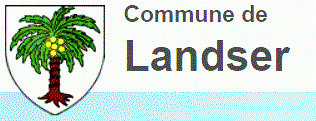|
Town hall of Landser 7, Place de la Paix 68440 Landser |
Téléphone: 03.89.81.31.05 Fax: 03.89.26.84.17 |
||
Opening Hours of the secretariat:
|
Secretary-assistant: Tél: 03.89.81.47.30 Vault - Showroom: Tél: 03.89.81.47.47 |
|
History Listed in 1246, the borough depended on the lords de Butenheim who had there a castle yielded to the bishop of Basle, then towards 1300 to the Hapsburg. Landser was the seat of the seigniory of the same name, divided from the administrative point of view into top and low bailliage which included until 45 localities including the forest of Hardt. Quoted like city in the 14th century, Landser was several times destroyed. It lost any importance in 19th century at the profit of Sierentz because of its decentred position in a hill country, aside of the traffic ways and the railway line Mulhouse-Basle. In 1929, salésiens fathers created here a school of agriculture which, after the war, became a college. The founder of their order, Don Bosco (1815-1888) was born in the area of Turin and its name remains associated with education and the love of youth. |
|
|
|
Habitat At number 1 is installed the town hall in a building of 16th century fitted out with a turn-staircase. At the left, one sees a very narrow half-timbered house with the first floor in corbelling, then at the corner, a beautiful masonry with an oriel.
|
|
Church and cemetery Mentioned for the first time in 1268, the church dedicated to Our Lady of the Assumption and place of pilgrimage to the Virgin, carries on the pediment the date of 1776 which could correspond to a transformation. On right-hand side of the entrance hall is leaned a monumental tombstone going back to 1862 and showing within a rectangular framework, a realistic scene, the Resurrection of Christ. On the other side, «the first stone », sealed in the wall, points out the blessing of the future sanctuary by the priest Zeller. At the front, a square contains the tombs of the Wendling: Jean-Michel Wendling in 1776, royal notary of the bailliage of Landser is the patriarch of the family. He is buried with one of his sons and successor, Michel-Xavier Antoine, deceased in 1789. The second son Charles-Xavier-Ignace (1739-1817), royal notary, baillif and judge of Chalampé is the father of Antoine (1786-1847), notary and mayor of Landser of 1816 to 1821. The third son, Pierre-Jean-Baptiste (1776-1848), iron merchant, tax collector of the direct taxes, mayor of Landser of 1805 to 1808, is the father of Robert-Gabriel (1814-1860), mayor of Habsheim and general adviser. At the front stands a rather large stone cross with Christ and holy Mary-Magdalena at its base, which is due to the sculptors Fritschy and Jacober. It points out an epidemic of cholera from which the inhabitants of Landser escaped miraculously. At the back of the cemetery, an ossuary contained in its time a group of Christ at the Mount of Olives whose principal figure, Christ on his knees, is exposed at the church entrance, on the right, in a niche. The imposing organ case of 1789, of baroque style, is due to Martin Bergäntzel. It overhangs four paintings of the middle of the 18th century accreditted to Mathis Jehl, from Sélestat: holy Anne and holy Joachim, holy Léonard, holy Sebastien to which was attached a brotherhood and Our Lady of the Rosary which was the subject of a pilgrimage. The fresco of the nave, a copy of the Transfiguration of Raphaël, and that of the chorus, are from Ebel from Fegersheim (1892). The master-altar is surmounted by a painting of the Assumption, the side altars by Our Lady with Saint Joseph and the Crowned Heart with Holy Anne, of H. Kayser. The stations of the cross is from Deschwanden. In the right side chapel, a baroque statue of holy Catherine surmounts a reliquary in the shape of coffin containing the remainders of the saint Justin martyr, brought back from Rome in 1825 by Henri Wagner. On each side, baroque statues of holy Elisabeth of Hungary making alms at a poor and of holy king Louis with in the hand three nails and a crown of spines. In the opposite chapel, a gothic pietà was the subject of a famous pilgrimage in its time, testified by the many ex-votos fixed on the wall. On right-hand side of the church, beside the presbytery, stands the old house of the family Goetzmann, baillif from father to son, from 1688 to 1771. Most famous was Louis-Valentine (1709-1794), member of the Parliament of Maupéou. Its quarrel with Beaumarchais in 1773 had a repercussion in all France. Author of several works of history and jurisprudence, Voltaire speaks about him with praise. He died on the scaffold in 1794 in Paris. Armorial bearings decorate the pediment of the gate of input: the blazon of the Goetzmann with three clover and two lions, surmounted by a scallop shell, that of the family Gabelis of Reichholz and the year of 1657, date of construction. |
Old landmark of Landser |
|
Redemptorists convent 50 meters further, one arrives at the convent built in 1659 and occupied by the fathers capuchins until the Revolution. In 1842, the redemptorists settled there but remained there only until 1873. In 1931, sisters of the same order established there at their turn. |
